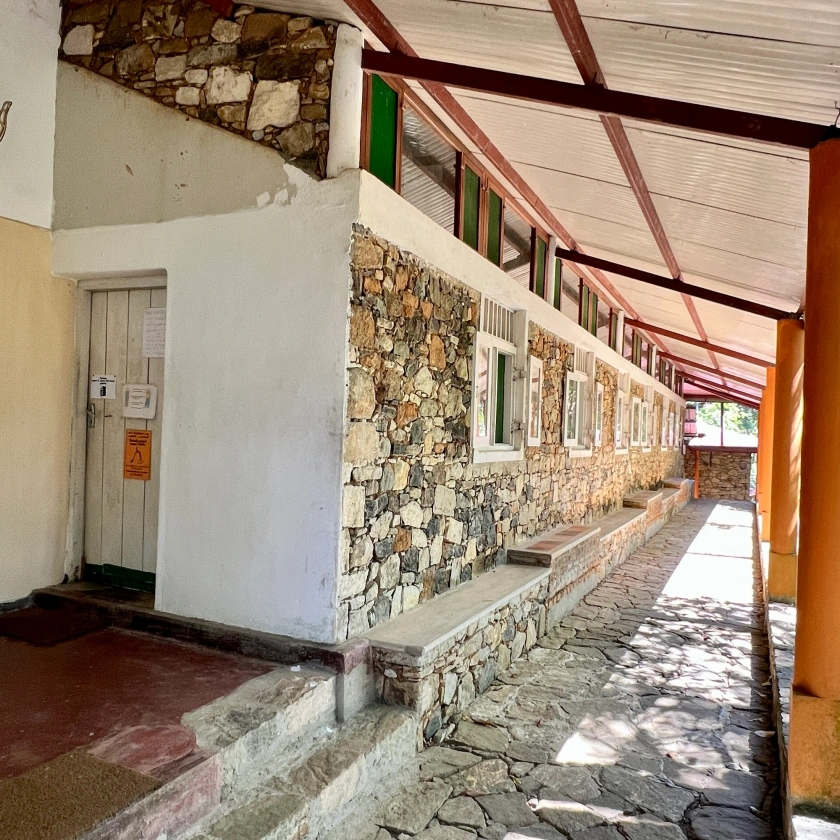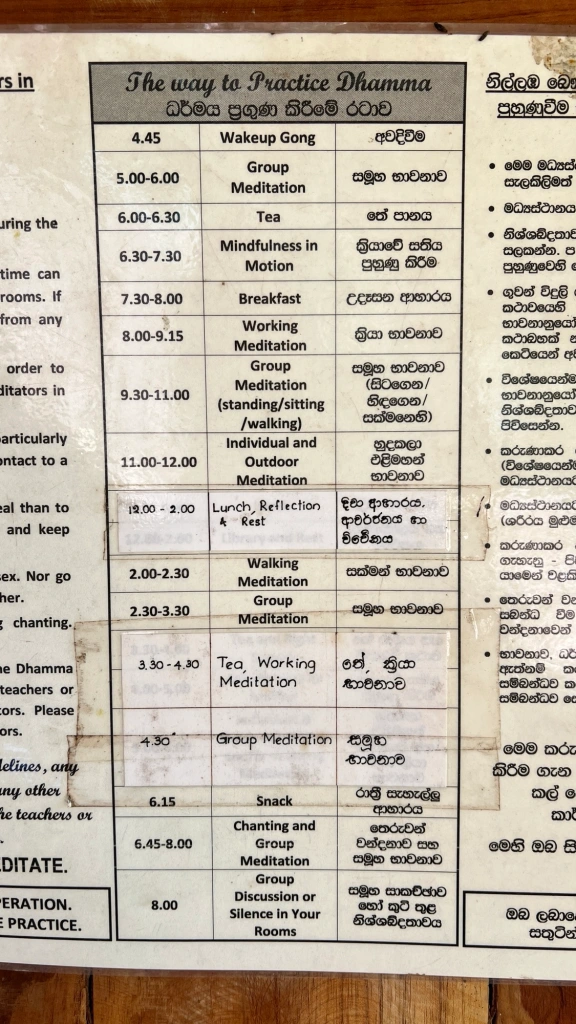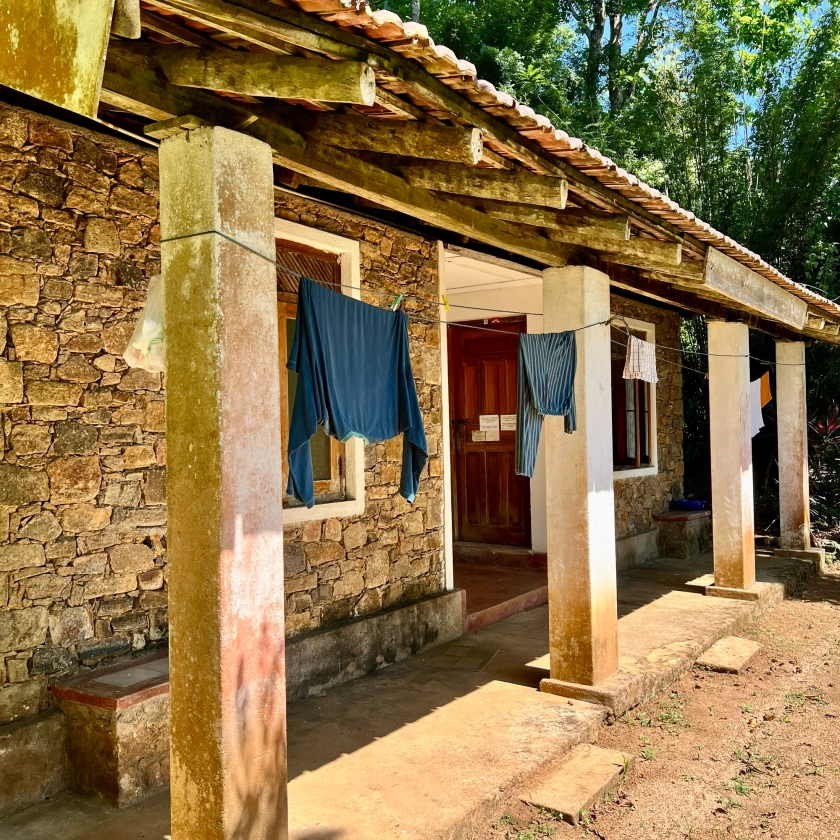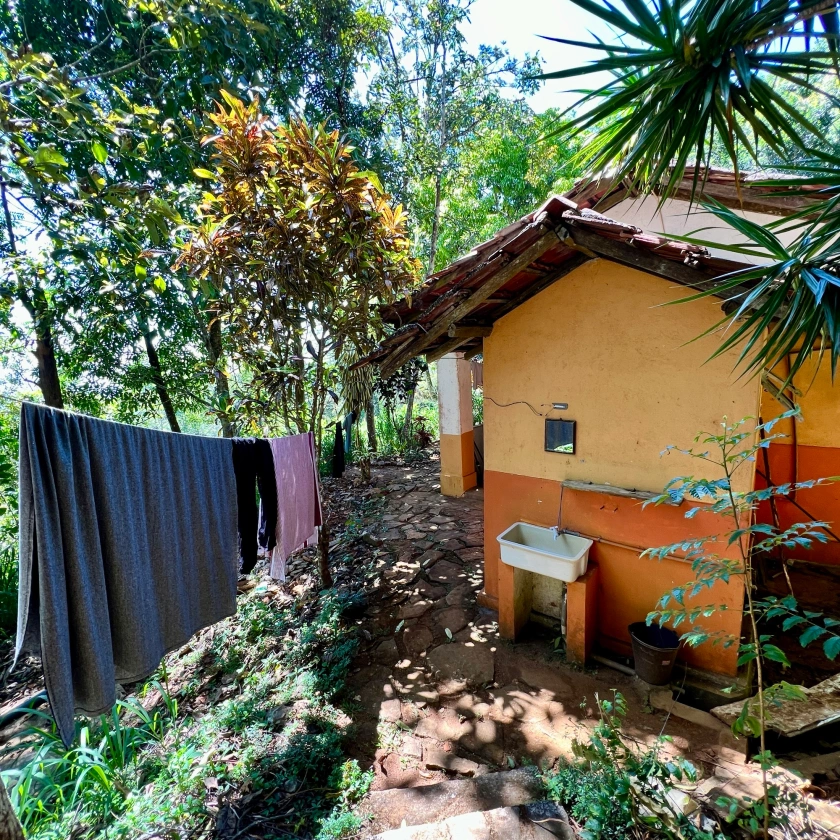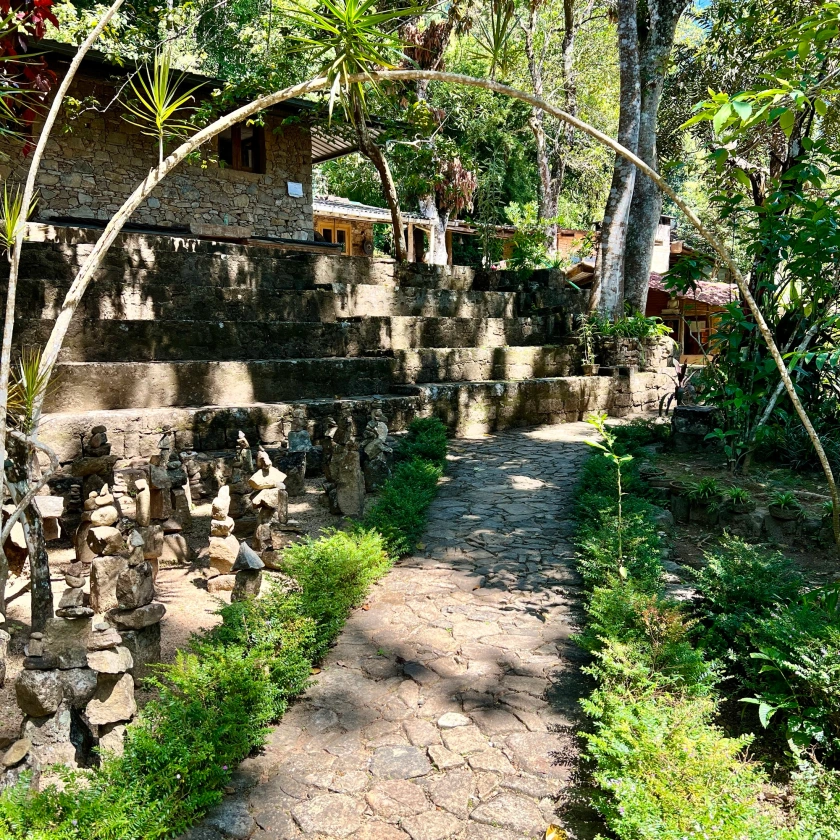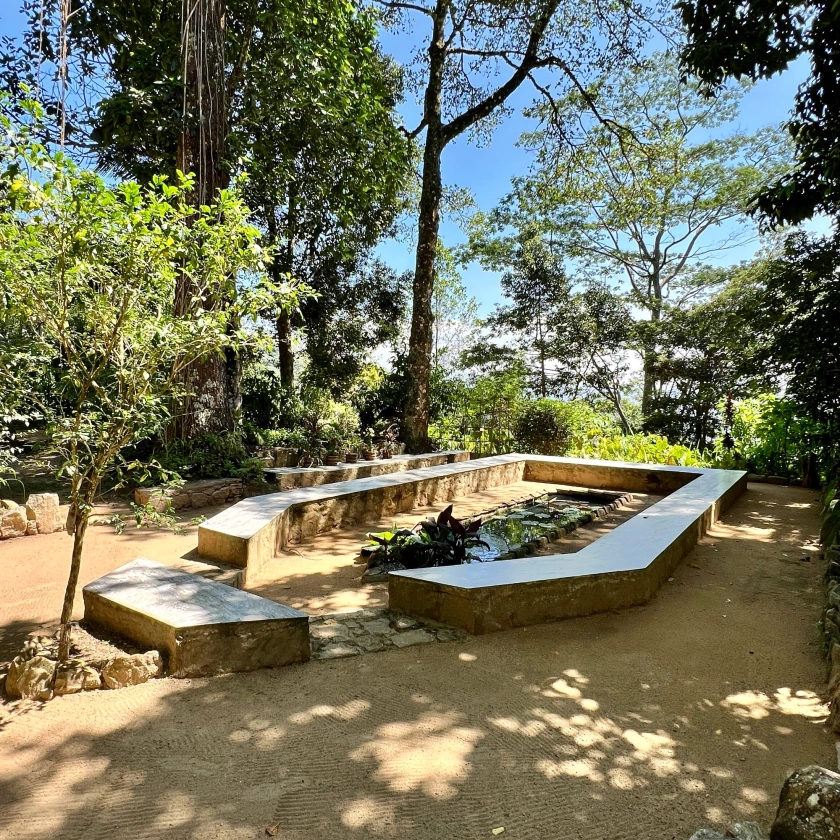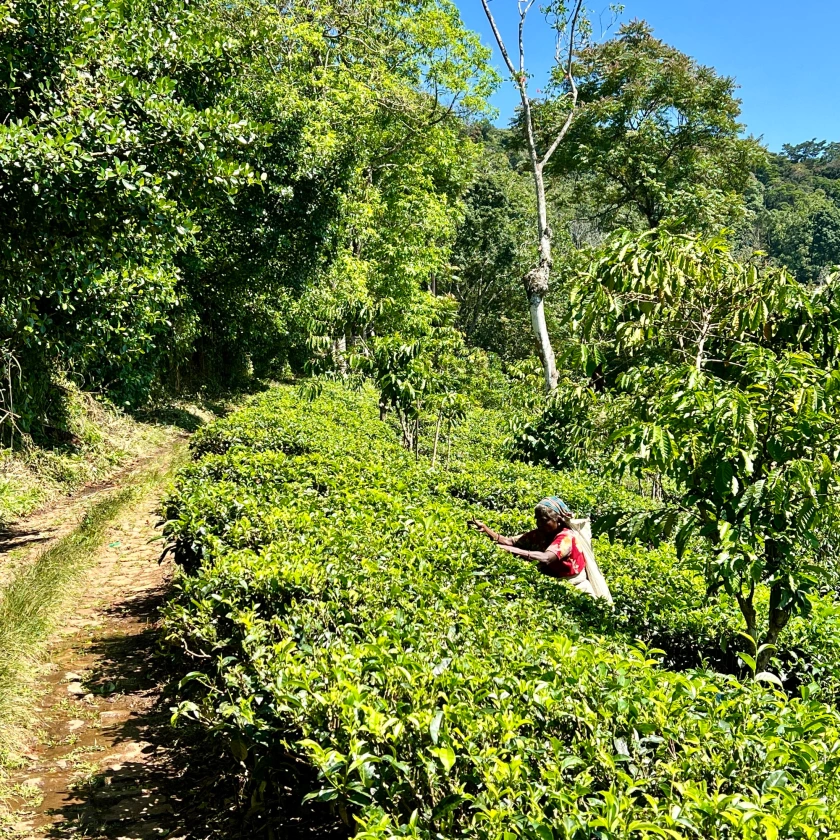Location: South of Kandy, Central Province, Sri Lanka. Google Maps location.
Tradition: Satipaṭṭhāna-based meditation, consisting of open awareness, and observation of mental and physical phenomena. Includes both sitting and walking meditation.
Practice intensity: 6 out of 10. As I only visited, I cannot say for sure. But the centre is far from anywhere to go visiting, and there is a general mood of quiet meditation practice, so I expect you would not have much opportunity for messing around. Plus a meditator there has updated me that not all meditators spend their days in practice. Some are doing yoga, drinking tea, or writing instead.
Accommodation: Twin rooms, male and female accommodation areas separated.
Food: Vegetarian. Served at 7.30am and midday. (For those observing the precept to eat before midday, an earlier meal can be arranged.)
Min/Max stay: There are two 6-day retreats each month, so I suppose you should stay for at least one of these. No upper limit.
Cost: Donations are welcome.
Clothing: Simple plain clothes are acceptable. See picture below.
Transport: The Contact Us page on the centre’s website explains the bus route. Just note it is best to travel to the centre from Kandy, as opposed to other cities. If you are travelling as more than one, consider hiring a tuktuk or two between your group. The bus ride is winding and crowded with nowhere to stow baggage, and once you get to the turn-off, you will anyway have to take a tuktuk up the remaining 3km road, which is extremely rough and therefore no good for a car, and too much elevation gain to walk with baggage. It is possible to walk down when leaving. For tuktuks from Kandy at good prices, try the PickMe app, a Sri Lankan Uber.
Contact: The website is at https://nilambe.lk/ where you will find contact details and directions to the centre. You are expected to contact them to book a retreat, as the centre is sometimes booked up. However, in arranging a visit, I emailed twice and called both of their phone numbers and could not get any response. So I recommend you email well in advance. Or add the phone number to your WhatsApp then message.
Visas: 30 days on arrival, which can be arranged online at http://www.eta.gov.lk/slvisa/. After arrival into Colombo, you can go to the Immigration Dept for extensions up to 6 months. See the Sri Lanka visa update here for details.
—
Nilambe (pronounced nee-lam-bay) is famous throughout Sri Lanka, and is well-known outside the country too. You can read about it here, so I won’t rewrite the history.
The centre is set high in the hills south of Kandy, which is a picturesque and historical city in the centre of the island. Kandy is worth a visit on the way in or out, so best to factor that into your travels. Although getting to the centre is a bit of a journey, it’s fair to say the remoteness makes it more peaceful and less distracting. First, you take a local bus from Kandy city centre (ask around for the Delthota bus, I took number 633/1) for about an hour up a narrow and winding road. When you reach the Office Junction stop, step down and ask any of the tuktuk drivers hanging around there to take you up to Nilambe. It may cost around USD 3, which seems a lot for a mere 3km ride, but once you see the poor state of the road, you’ll understand why the drivers want to be paid well for their trouble.
The centre itself is set on a forested hillside so it’s well-shaded and mostly cool. The buildings (and paths) are hand-built from stone, which should keep the cool in during warm summers, and probably keeps the warmth in during the cooler season. There is a long meditation hall with seating inside and out, and a hall on the hillside above that which might be disused or for Dhamma Talks. The dining hall also has indoor and outdoor seating. Everywhere you go there are notices in English to remind you to observe noble silence, to be mindful, and to be in the spirit of the training. There is also a library that seems well-stocked, although it was locked when I visited. The centre publishes a lot of small booklets based on the teacher’s talks, which are freely available.
The teacher, Mr Upul Gamage, is a peaceful lay-man who reminded me of a monk: quiet and gentle, taking his time as if he lives in his own timezone, and always ready to chat if you have queries. The story of how he came to head the centre is also on the website.
The accommodation blocks seem a little old, but have all the basics. I caught sight of showers and western toilets external to the rooms. The rooms sleep two people each, but I expect you would only share once all the rooms are occupied. The centre did not seem fully occupied while I was there. Also, monks and nuns get separate accommodation. As I was not allowed to visit the female accommodation area, I can only report I was told the facilities there are the same.
Keep in mind that centres like this run on the traditional Buddhist practice of dāna, or unprompted giving. This means they won’t ask you to pay a per-night fee, but that doesn’t mean the centre doesn’t rely on your generosity to keep going. So please be generous with a donation for food and to ensure the facilities can be kept in good condition for future yogis. And with the broken-down state of the Sri Lankan economy these days, what seems a small amount of money elsewhere in the world can go a very long way here.
I cannot tell you much more as I have not trained there. Although they run two 6-day retreats each month (one in English, one in Sinhala), yogis are welcome to stay for as long as they like. That means if you are not a Sinhala speaker, you can continue on through the Sinhala retreats. And since the meditation method they teach does not directly follow any of the major meditation schools out there, I suppose you would be best going there with a blank state and seeing what you can learn from Mr Upul’s method. That is to say, if you are a practitioner with your own practice method and don’t take kindly to being instructed in another form, it might be best to train elsewhere. (In such a case, Sumathipala in Kanduboda might be more suitable.)
A meditator at Nilambe updated me that they were encouraged to continue practicing whatever legacy practice they had brought with them to the centre. So this is helpful for those who have an existing practice and wish to push on.


